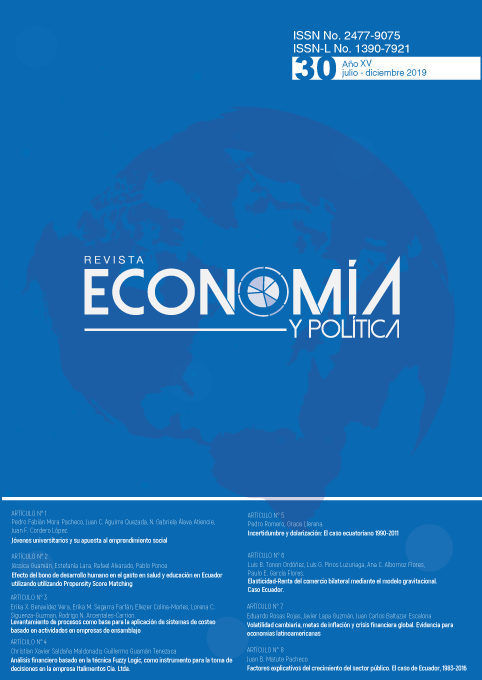Exchange rate volatility, inflation targeting and global financial crisis. Evidence for Latin American economies
DOI:
https://doi.org/10.25097/rep.n30.2019.07Keywords:
Modelos GARCH, volatilidad cambiaria, metas de inflación, crisis financiera globalAbstract
The purpose of this research is to identify the asymmetric effect generated by positive and negative impacts on the exchange rate volatility. In addition to determining the effect generated by the implementation of the inflation targeting regime (IT) and the global financial crisis (GFC) in the conditional variance of the main exchange rates of Latin America (Brazil, Chile, Colombia, Mexico and Peru). We use an asymmetric model of Generalized Autoregressive Conditional Heteroskedasticity, with t-student innovations (ARIMA-GJR-GARCH), applied on daily data from 1997 to 2019. The main findings show that, there is a greater impact of exchange rate depreciations on the exchange rate volatility. In addition, it was found that the IT regime has increased the exchange rate volatility, mainly in Brazil, Chile and Mexico. Finally, the 2008 GFC seems to have generated a climate of greater exchange rate volatility in the region.
Downloads
References
Arestis, P., y Sawyer, M. (2013). Moving from Inflation Targeting to Prices and Incomes Policy. Panoeconomicus, 60(1), 1-17. DOI: https://doi.org/10.2298/PAN1301001A
Ball, L., y Sheridan, N. (2005). Does inflation targeting matter? en Bernanke, B., Woodford, M. (Eds.), The Inflation Targeting Debate. The University of Chicago Press, Chicago, 249–276.
Berganza, J.C., y Broto, C. (2012). Flexible inflation targets, forex interventions and exchange rate volatility in emerging markets. Journal of International Money and Finance, 31, 428–444, Disponible en: https://www.bde.es/f/webpi/SES/staff/berganzajuancarlos/files/flexibleinflationtargets.pdf
Bernanke, B. S. (2004). The Great Moderation, discurso ante la Eastern Economic Association, Washington, 20 de Febrero, Disponible en: www.federalreserve.gov/boarddocs/speeches/2004/20040220/default.htm#f1.
Black, F. (1976). The pricing of commodity contracts, Journal of Financial Economics, 3(1/2), 167-179. DOI: https://doi.org/10.1016/0304-405X(76)90024-6
Böfinger, P. y Wóllmerschaeuser, T. (2001). Managed floating: understanding the New International Monetary Order, Centre for Economic Policy Research (CEPR), Discussion Paper No. 3064. Recuperado de: https://www.econstor.eu/bitstream/10419/48479/1/570611571.pdf
Bollerslev, T. (1986). Generalised Autoregressive Conditional Heteroskedasticity, Journal of Econometrics 31(3), 307-27. DOI: https://doi.org/10.1016/0304-4076(86)90063-1
Brooks C. (2015). Introductory Econometrics for Finance (3rd ed.). Cambridge Inglaterra: Cambridge University Press.
Cavoli, T. (2009). Is fear of floating justifies? The East Asia experience, Journal of Policy Modeling, 31(1), 1-16. DOI: https://doi.org/10.1016/j.jpolmod.2008.03.002
Cohen, M. (2012). The Global Economic Crisis in Latin America: Impacts and Responses, Ed. Taylor and Francis.
Coudert, V., Couharde, C., y Mignon, V. (2011). Exchange Rate Volatility Across Financial Crises. Journal of Banking and Finance 35(11), 3010–3018. DOI: https://doi.org/10.1016/j.jbankfin.2011.04.003
Edwards, S., (2006). The relationship between exchange rates and inflation targeting revisited. In: Mishkin, F., Schmidt-Hebbel, K. (Eds.), Monetary Policy Under Inflation Targeting. Banco Central de Chile, Santiago, pp. 373–413.
Engle, R. F. (1982). Autoregressive Conditional Heteroskedasticity with Estimates of the Variance of United Kingdom Inflation, Econometrica 50(4), 987-1007. Recuperado de: https://www.jstor.org/stable/1912773
Engle, R.F. y Ng, V. N. (1993). Measuring and testing the impact of news on volatility, Journal of Finance, 48(5), 1749-1778. DOI: https://doi.org/10.1111/j.1540-6261.1993.tb05127.x
Frenkel R., y Rapetti M. (2010). A Concise History of Exchange Rate Regimes in Latin America, Working Paper 2010-01, University of Massachusetts, Amherst, MA. Disponible en: https://pdfs.semanticscholar.org/6daf/e27ca9b28bb85365912c4c4a2a16a5846d71.pdf
Gali, J., Monacelli, T. (2005). Monetary policy and exchange rate volatility in a small open economy. Review of Economic Studies 72, 707–734. Disponible en: http://www.crei.cat/wp-content/uploads/users/pages/roes8739.pdf
Glosten, L. R., Jagannathan, R. y Runkle, D. E. (1993). On the Relation Between the Expected Value and the Volatility of the Nominal Excess Return on Stocks, The Journal of Finance 48(5). DOI: https://doi.org/10.1111/j.1540-6261.1993.tb05128.x
Hsu S. (2013). Financial Crises, 1929 to the Present Books, Edward Elgar Publishing, No. 14419.
Fondo Monetario Internacional (2019). Annual Report on Exchange Arrangements and Exchange Restrictions 2018. Washington, DC: IMF. DOI: http://dx.doi.org/10.5089/9781484396773.081
Mandelbrot, B. (1963). The variation of certain speculative prices, The Journal of Business, 36(4), 394-419. DOI: http://dx.doi.org/10.1086/294632
McLeod, A. I. y Li, W. K. (1983). Diagnostic checking ARMA time series models using squared-residual autocorrelations. Journal of Time Series Analysis 4(4): 269–273. DOI: https://doi.org/10.1111/j.1467-9892.1983.tb00373.x
Mishkin F.S., (2001). Prudential supervision: why is it important and what are the issues? en Mishkin F.S. (ed.), Prudential Supervision. What Works and What Doesn’t, National Bureau of Economic Research Working Paper Series, No. 7926.
Mishkin, F.S., y Savastano, M.A. (2001). Monetary policy strategies for Latin America. Journal of Development Economics 66, 415–444. Disponible en: http://isiarticles.com/bundles/Article/pre/pdf/24731.pdf
Nelson, D. B. (1991). Conditional Heteroskedasticity in Asset Returns: A New Approach, Econometrica 59(2), 347-70. Recuperado de: https://www.jstor.org/stable/2938260
Obstfeld, M., Shambaugh, J., y Taylor, A. M. (2005). The Trilemma in History: Tradeoffs among Exchange Rates, Monetary Policies, and Capital Mobility, Review of Economics and Statistics 3, 423–38. Disponible en: https://eml.berkeley.edu/~obstfeld/ost12.pdf
Ouyang, A. Y., Rajan, R. S. y Li, J. (2016). Exchange rate regimes and real exchange rate volatility: Does inflation targeting help or hurt?, Japan and the World Economy, Elsevier, 39, 62-72. DOI: 10.1016/j.japwor.2016.07.002
Perrotini H. I. (2007). El nuevo paradigma monetario. Revista Economía UNAM. (11), 64-82. Disponible en: http://www.redalyc.org/service/redalyc/downloadPdf/3635/363542892001/6
Rose, A. K. (2007). A stable international monetary system Emerges: Inflation targeting is bretton woods, reversed. Journal of International Money and Finance, 26(5), 663-681 DOI: https://doi.org/10.1016/j.jimonfin.2007.04.004
______ (2014). Surprising similarities: recent monetary regimes of small economies. J. Int. Money Finance 49A, 5–27. Disponible en: https://www.frbsf.org/economic-research/files/Rose-AEPC2013.pdf
Stock, J., y Watson, M. (2003). Has the Business Cycle Changed? Evidence and Explanations. Federal Reserve Bank of Kansas City, Kansas City (2003). Disponible en: https://www.princeton.edu/~mwatson/papers/jh_2.pdf
Taylor, S. J. (1986). Forecasting the Volatility of Currency Exchange Rates, International Journal of Forecasting 3(1), 159-70. DOI: https://doi.org/10.1016/0169-2070(87)90085-9
Walsh, C. (2009). Inflation targeting: what have we learned? International Finance 12(2), 195–233. DOI: https://doi.org/10.1111/j.1468-2362.2009.01236.x
Downloads
Published
How to Cite
Issue
Section
License
The Journal declines any responsibility for possible conflicts derived from the authorship of the works that are published in it.
The University of Cuenca in Ecuador conserves the patrimonial rights (copyright) of the published works and will favor the reuse of the same ones, these can be: copy, use, diffuse, transmit and expose publicly.
Unless otherwise indicated, all contents of the electronic edition are distributed under a Creative Commons Attribution-NonCommercial-ShareAlike 4.0 International License.






